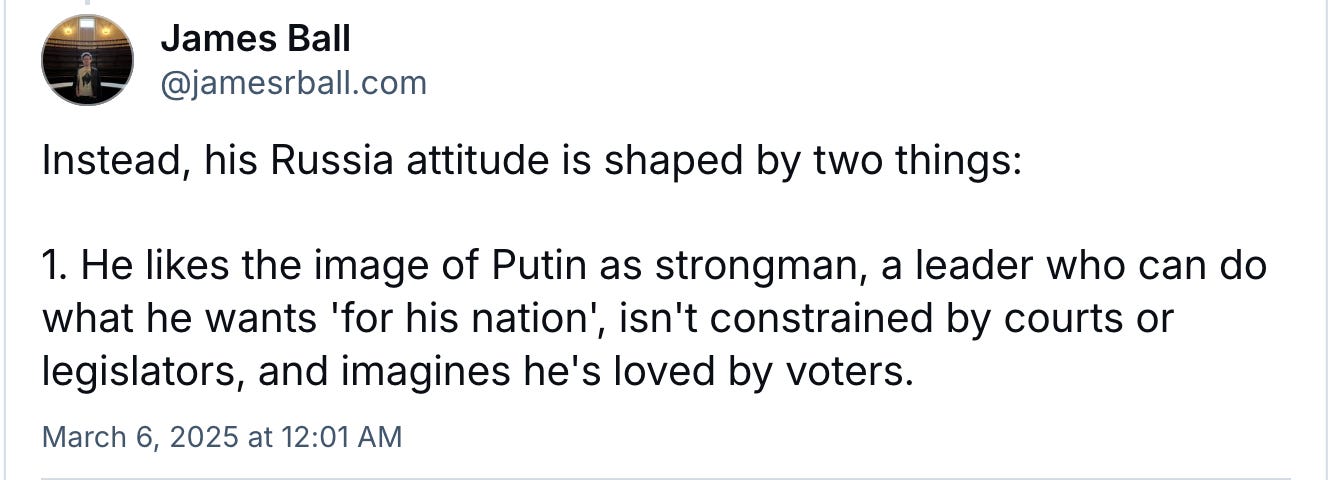The Cold War was not a misunderstanding
Neither is Trump's alliance with Putin
The Cold War was not a misunderstanding. It was not started for the express purpose of building up a military-industrial complex or to provide a useful wedge for partisan domestic politics. It was a rational, even moral response to a fundamental clash of values and interests. That is the view of world-renowned historian Stephen Kotkin, author of a magisterial multi-volume biography of Joseph Stalin.
In Kotkin’s telling, the West, led by the United States, could have chosen not to stand up to the Soviet despot’s brutal regime, the suppression of human rights at home and in its satellite states, the attempts to export tyranny across Eurasia and beyond, the blockade of Berlin, the support for North Korea’s invasion of South Korea and so on.
“We don't have to blame someone for the Cold War. We have to give credit for the Cold War. The Truman administration deserves credit for standing up to Stalin's regime, for standing up to these actions, for saying… we're not just going to take this.”
Kotkin is right. The Cold War was an ideological confrontation between liberty and authoritarianism, free markets and a command economy, human dignity and the Gulag. But there was another dimension often forgotten, particularly in Europe: the Cold War was a religious conflict.
“Soviet Communism starts with an atheistic, godless premise” wrote John Foster Dulles, the future US Secretary of State, in his book, War or Peace, published in 1950. “Everything else flows from that premise. If there is no God, there is no moral or natural law.” As such, for the US, the Cold War was also a moral crusade against a godless adversary which persecuted the religious, destroying churches, synagogues and mosques.
Indeed, upon signing a bill to include the words "Under God" in the Pledge of Allegiance in June 1954, President Dwight Eisenhower proclaimed that he was “reaffirming the transcendence of religious faith in America’s heritage and future; in this way we shall constantly strengthen those spiritual weapons which forever will be our country’s most powerful resource in peace and war.”
The absence of this spiritual dimension, following the collapse of the Soviet Union, is instructive when grappling with the question of why Donald Trump’s America has switched sides. The conspiratorial take spans everything from Vladimir Putin possessing compromising material on Trump to the US president being a literal Russian asset. The reality is likely to be a little more dull, if no less dangerous. As James Ball, political editor at The New European, puts it:
There is still an ideological struggle going on. But this time, the US and Russian governments are in lockstep. On LGBTQ rights, diversity, equity and inclusion, cancel culture. This is what made Vice President JD Vance’s speech to the Munich Security Conference last month quite so chilling. Instead of addressing Ukraine’s sovereignty and threats to European security, Vance launched into a blistering attack on European ideals.
He railed against “the retreat of Europe from some of its most fundamental values — values shared with the United States of America,” which apparently include opposition to buffer zone laws outside of abortion clinics in Britain, specifically referencing the case of Adam Smith-Connor. As if to eradicate any doubt, Vance then compared European policies with the Soviet Union’s censorship of dissidents.
American leaders have long implored Europeans to do more for their own defence. In his final policy speech in office, Robert Gates, Secretary of Defence under George W. Bush and Barack Obama, lambasted Nato allies, warning the alliance faced “a dim if not dismal future” unless member states contributed more money, weapons and soldiers. But never before has the US demanded European nations align with its domestic political proclivities.
The Trump administration’s defection to Putin’s Russia is not a misunderstanding. It is a clear-eyed alliance between kindred spirits.
If you enjoyed this newsletter, please tell someone about it. Personal recommendations are the best way to build things like this.






It’s impossible to talk about the Cold War without talking about Afghanistan—something people conveniently forget when they reduce it to just an ideological standoff between the U.S. and the Soviet Union. Afghanistan was where the Soviet empire came to die. It was Afghanistan's fighters, not just American policy, that drained Moscow’s resources, shattered its illusion of invincibility, and sped up the collapse of the USSR. And yet, somehow, we’re still treated as footnotes in a history we helped write.
Now, watching Trump cozy up to Putin, I can’t help but think: does he even realise how this story ends? That empires don’t last, that their so-called alliances crumble the moment they stop being useful? America once backed Afghan resistance fighters as part of its Cold War strategy, only to turn its back on us when we were no longer convenient. Ukraine should be taking notes.
And then there’s this absurd reversal—America, once the self-proclaimed defender of democracy, now parroting Russian propaganda, treating Europe like an ideological punching bag instead of an ally.
Afghanistan was where the last Cold War ended. And looking at this mess, I wonder if, once again, it’s where the cracks in a new global order will start to show.
Between kleptocrats